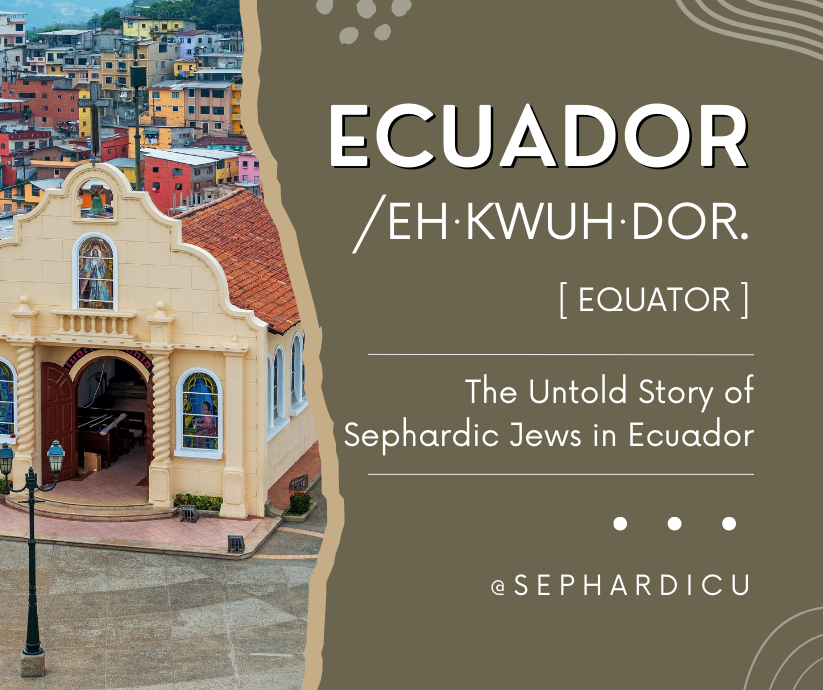Ecuador, known for its vibrant culture and rich history, holds a lesser-known but fascinating chapter in the story of Sephardic Jews. The presence of Jews in Ecuador dates back to the 16th and 17th centuries, when Sephardic Jews began arriving from Spain and Portugal due to the Spanish Inquisition. This tale of resilience, secrecy, and cultural survival reveals how deeply intertwined global Jewish history is with local traditions.
Colonial Period and Crypto-Jews: The Arrival
The arrival of Sephardic Jews in Ecuador occurred during a tumultuous time in history. From 1580 to 1640, under the Iberian Union, King Philip II of Spain ruled both Spain and Portugal, leading many Jews to migrate to the Viceroyalty of Peru, where Inquisition surveillance was less stringent. Within this vast territory, many “new Christians,” as conversos were called, found refuge in remote areas. Loja, in particular, emerged as an important destination for these migrants, as indicated by the studies of historians like Ricardo Ordoñez Chiriboga.
In places like Loja, Zaruma, and Cuenca, Sephardic settlers preserved their traditions in secrecy. Despite the risks of persecution, they adhered to dietary laws, maintained distinctive burial practices, and practiced endogamous marriages, all while outwardly conforming to Catholic norms. This hidden legacy was often passed down through generations, with many descendants still speaking Ladino and practicing ancient customs.
Cultural and Genealogical Influence: Secret Traditions
In rural regions, the Sephardic influence can still be observed today. Families often continue to observe Jewish customs, even as they blend these practices with local traditions. The gastronomy of Loja, for example, reflects these influences through traditional dishes that adhere to kashrut, the Jewish dietary laws. This culinary heritage offers a delicious testament to the enduring legacy of Sephardic culture.
Interestingly, Laron syndrome, a rare genetic disorder characterized by growth hormone receptor dysfunction, has a notably high incidence in Loja. This genetic link is attributed to the endogamous practices among crypto-Jewish descendants, highlighting a unique intersection of genetic and cultural history.
The 20th Century: A Shift in Demographics
By the early 20th century, the Jewish community in Ecuador was quite small. In 1904, there were only four recognized Jewish families, and by 1917, a survey indicated the presence of just 14 Jews in the country. However, this changed dramatically with the rise of Nazism and the Holocaust in Europe. Between 1933 and 1943, approximately 2,700 Jewish refugees arrived in Ecuador, leading to a peak population of around 4,000 Jews in the 1950s, primarily in Quito.
During this time, the Sephardic influence began to blend with Ashkenazi traditions as Jews from various backgrounds came together in Ecuador. The community established businesses, textile factories, and even furniture craft using the abundant local balsa wood. This period marked a significant chapter in the history of Jews in Ecuador, who navigated both opportunities and challenges in their new homeland.
Modern Recognition and Research
The late 20th and early 21st centuries marked a turning point in the recognition of Sephardic Jewish heritage in Ecuador. As the country modernized and became more open to diverse religious practices, scholars and descendants began to investigate and document their Jewish roots.
The establishment of the Cultural Center for Sephardic History in Loja in 2023 represents a significant step in acknowledging and celebrating this rich heritage. This center aims to preserve and promote the Jewish-Spanish heritage of the region through research, exhibitions, and educational programs.
Prominent figures like Ricardo Ordoñez Chiriboga and Gabriel Gualán Maldonado have been instrumental in connecting modern families to their Sephardic ancestors, helping to illuminate the often-hidden history of these communities. The integration of Sephardic names, such as Navon, Moreno, and Haddad, among established Ecuadorian families serves as a testament to this legacy.
Contemporary Jewish Community: Reviving the Past
Today, the Jewish community in Ecuador, predominantly of German origin, numbers around 290 individuals. The community is characterized by its strong organization, with institutions like the Asociación de Beneficencia Israelita serving as the central body for Jewish cultural affairs. Educational initiatives, such as the Colegio Experimental Alberto Einstein in Quito, continue to foster Jewish identity among both Jewish and non-Jewish students.
Efforts to revive and celebrate Sephardic heritage are gaining momentum. The Cultural Center for Sephardic History plays a crucial role in this revival, serving as a beacon for those interested in exploring and understanding their roots.
Conclusion: A Legacy of Resilience
The story of Sephardic Jews in Ecuador is a testament to the resilience of a people who, despite centuries of persecution and forced conversion, managed to keep their traditions alive. From the secretive practices of crypto-Jews in the colonial era to the modern efforts to reclaim and celebrate this heritage, the narrative is one of perseverance and cultural endurance.
As Ecuador continues to explore and celebrate its diverse historical influences, the Sephardic heritage remains a vital part of the nation’s cultural tapestry. Through ongoing research, cultural initiatives, and the efforts of dedicated individuals, the rich history of Sephardic Jews in Ecuador is finally receiving the recognition it deserves.








Ohr HaChaim Yomi – Emor